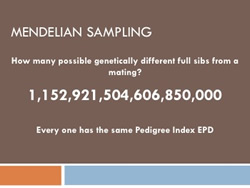Implementing Marker-assisted EPDs
by Kindra Gordon for Angus Productions Inc.
MITCHELL, Neb. (Nov. 30, 2011) — “Genomics information is here, and it works,” Matt Spangler said as he discussed the implementation of marker-assisted expected progeny differences (MA-EPDs) in the United States. Spangler, a beef geneticist with the Department of Animal Science at the University of Nebraska–Lincoln, spoke Nov. 30 at the Range Beef Cow Symposium XXII in Mitchell, Neb.

Matt Spangler
Spangler noted the industry has been able to utilize genomics for identifying genetic defects and parentage testing. This has allowed producers to test and find carriers and remove them from the breeding population, he explained.
Now, the next phase of utilizing genomic information is for more complex trait selection. He shared that collecting DNA information early in a calf’s life allows the opportunity to get a better picture of its genetic potential.
“For the seedstock breeder especially, genomic data provides an opportunity to make faster genetic change,” Spangler stated.
He acknowledged that when genomics first came to the marketplace, the information presented some confusion and a “jumble of information” for producers.
But, marker information is being incorporated into EPDs, which is helping bring the genomics data to the industry. As examples, Spangler pointed to the American Angus Association, which has been including genomic predictions into EPD calculations to produce marker-assisted EPDs for a growing number of traits since 2009. The American Hereford Association is also on the verge of releasing a MA-EPD, and Spangler said he anticipates other breeds will soon follow.
Going forward, Spangler emphasized that the adoption of a genomic prediction must be centered on the gain it offers in EPD accuracy. That is the benefit — getting more information on animals at a younger age, which, in turn, leads to faster rates of genetic change, he explained.
Spangler noted that it is often questioned whether genomics data works. He said the real question to ask is, “How well does it work?” He said the answer to that question is related to how much of the genetic variation the marker test explains.
 MA-EPDs by themselves are not the silver bullet, Spangler emphasized. They need to be augmented with traditional EPD information. He reemphasized that genomics data primarily adds accuracy to existing EPDs, particularly on young animals.
MA-EPDs by themselves are not the silver bullet, Spangler emphasized. They need to be augmented with traditional EPD information. He reemphasized that genomics data primarily adds accuracy to existing EPDs, particularly on young animals.
“When you genotype animals," he explained, "the accuracy will always go up, but the EPD can go up or down because more information is being added to the EPD.”
“If the EPD accuracy is already 0.5 or 0.6, then it doesn’t impact accuracy as much,” he added.
In the future, Spangler said he anticipates new traits in the genomics area, such as healthfulness of beef, disease and tenderness. To this effort, he said continuing to collect phenotypes is critical, and predictions will continue to improve as more animal information is collected.
“We have more technology available to use in beef cattle than other species, and we probably use it the worst,” Spangler said in closing. He encouraged producers to utilize new technology so as not to leave money on the table. Spangler suggested that includes all the tools — from crossbreeding to EPDs to genomics.
“The fundamentals are still in place," Spangler told commercial bull buyers. "Use EPDs because genomics information is included in them, but pay attention to accuracy.”
To see Spangler's PowerPoint presentation, click here.
The biennial Range Beef Cow Symposium was hosted Nov. 29-Dec. 1 at the Mitchell Events Center, Mitchell, Neb., by the cooperative extension and animal science departments of the University of Nebraska-Lincoln, South Dakota State University, Colorado State University and the University of Wyoming. Comprehensive coverage of the event is provided online at www.rangebeefcow.com, an event coverage site provided by Angus Productions Inc. (API), publisher of the Angus Journal and the Angus Beef Bulletin.
Editor’s Note: API's coverage of the event is made available for distribution to all media via an agreement with the Range Beef Cow Symposium Committee and API. Headquartered in Saint Joseph, Mo., API publishes the Angus Journal, the Angus Beef Bulletin, the Angus Beef Bulletin EXTRA, and the Angus e-List, as well as providing online coverage of events and topics pertinent to cattlemen through the API Virtual Library. For questions about this site, or to notifiy us of broken links, click here.

